Photographs of
|
|
|
|||||||||
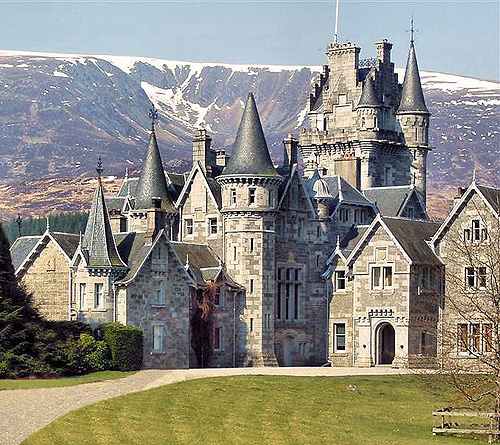 |
Ardverikie Castle Kinlochlaggan, Newtonmore, PH20 1BX, Scotland
Ardverikie House, built in the Scottish baronial style in 1870, is a private hous in the Highlands. It sits on a promontory overlooking King Fergus's Island with its ancient ruins. Its three mile private drive winds past the largest inland beach in the country and round the loch.
The house played host to Queen Victoria and Prince Albert for a month before they bought Balmoral.
It features in BBC's series Monarch of the Glenn. |
||||||||
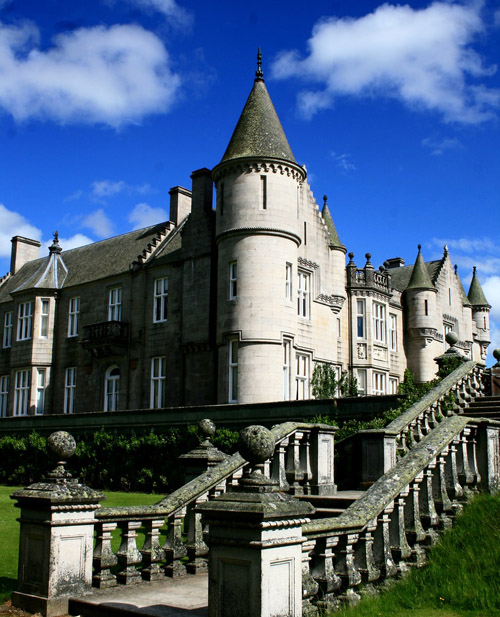 |
Balmoral Castle Royal Deeside Aberdeenshire |
||||||||
 |
Blackness Castle, Blackness, Scotland
Blackness Castle is a 15th-century fortress on the south shore of the Firth of Forth. It was built, on the site of an earlier fort, by Sir George Crichton in the 1440s. Blackness was then the main port serving the Royal Burgh of Linlithgow, one of the main residences of the Scottish monarch.
The castle, together with the Crichton lands, passed to King James II of Scotland in 1453, and the castle has been crown property ever since. It served as a state prison, holding inter alia Cardinal Beaton, and the 6th Earl of Angus.
When it was strengthened by Sir James Hamilton of Finnart in the mid-16th century, the castle became one of the most advanced artillery fortifications in Scotland. A century later, in 1650,.Blackness fell to Oliver Cromwell's army.
Some years after the siege, the castle was repaired, and again served as a prison and a minor garrison. Barracks and officers' quarters were added in the 1870s, when the castle was used as an ammunition depot.. It was briefly reused by the army during the First World War. It is now a Scheduled Ancient Monument, in the care of Historic Scotland. |
||||||||
 |
Blair Castle, Blair Atholl, Perthshire, Scotland
Blair Castle is the ancestral home of the Clan Murray, and was historically the seat of their chief, the Duke of Atholl,
The castle stands in Glen Garry, and commands a strategic position on the main route through the central Scottish Highlands.
The oldest part of the castle is the six-storey Cummings or Comyn's Tower, which retains some13th-century fabric, though it was largely built in the 15th century.
The castle is a category A listed building, and the grounds are included in the Inventory of Gardens and Designed Landscapes in Scotland. |
||||||||
 |
The Entrance Hall Blair Castle, Blair Atholl, Perthshire, Scotland
Blair Castle is the ancestral home of the Clan Murray, and was historically the seat of their chief, the Duke of Atholl,
The castle stands in Glen Garry, and commands a strategic position on the main route through the central Scottish Highlands.
The oldest part of the castle is the six-storey Cummings or Comyn's Tower, which retains some13th-century fabric, though it was largely built in the 15th century.
The castle is a category A listed building, and the grounds are included in the Inventory of Gardens and Designed Landscapes in Scotland. |
||||||||
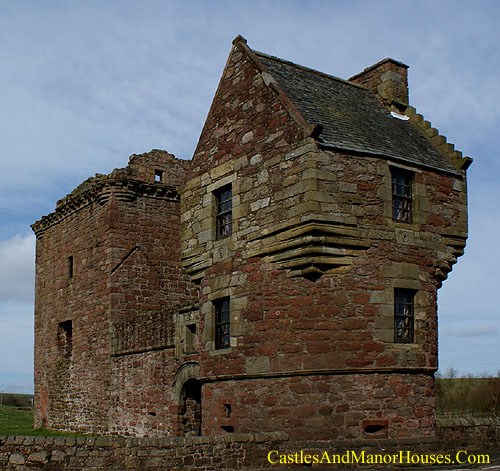 |
Burleigh Castle Perth and Kinross, Scotland
The remains of Burleigh Castle are located just outside the village of Milnathort, 1.5 miles north of Kinross, and now sits beside the A911 road.
The castle dates from the 15th and 16th centuries. The remains of the castle comprise the western part of what was once a square courtyard or barmkin. In the north-west corner, the original tower house survives largely intact (though one of the first floor windows has been greatly enlarged) to three storeys and a garret in height. The 5-foot-thick (1.5 m) walls rise to corbels which once supported a parapet walk. The roof and internal floors are now gone, although the vaulted basement remains. The turnpike stair in the north-east corner originally led up to a caphouse giving access to the parapet walk.
To the south-west is a 16th-century corner tower, two storeys high above a basement, which retains its roof. The tower is round at the base, and corbelled out to a square upper storey, and is a particularly fine and picturesque example of Scottish baronial architecture of the period. The two surviving towers are connected by a section of curtain wall pierced by an arched gate. Though now only a 'skin' of masonry, this wall once fronted a two-storey gatehouse. With its string-course, hood-mould over the gateway and moulded surround formerly containing a heraldic panel, this wall is an excellent example of small-scale but refined architectural sophistication of its period in Scotland.
|
||||||||
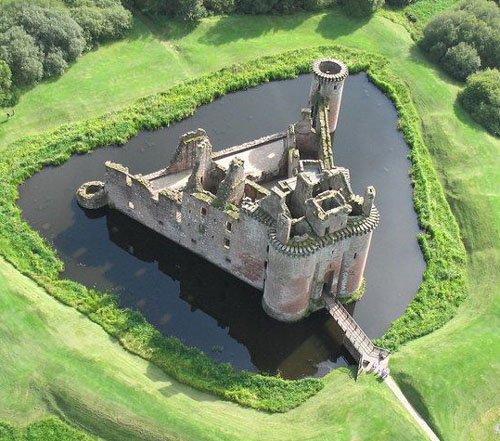 |
Caerlaverock Castle on the southern coast of Scotland 11 kilometres south of Dumfries on the edge of the Caerlaverock National Nature Reserve. |
||||||||
 |
Cawdor Castle, Cawdor, Scotland
Cawdor Castlelies 10 miles (16 km) east of Inverness. The castle is built around a 15th-century tower house, with substantial additions in later centuries. Originally a property of the Clan Calder, it passed to the upstart Campbell clan in the 16th century. It remains in Campbell ownership, and is now home to the Dowager Countess Cawdor
The castle is a category A listed building. Its grounds are included in the Inventory of Gardens and Designed Landscapes in Scotland, the national listing of significant gardens. |
||||||||
 |
Cawdor Castle, Cawdor, Scotland
Cawdor Castlelies 10 miles (16 km) east of Inverness. The castle is built around a 15th-century tower house, with substantial additions in later centuries. Originally a property of the Clan Calder, it passed to the upstart Campbell clan in the 16th century. It remains in Campbell ownership, and is now home to the Dowager Countess Cawdor
The castle is a category A listed building. Its grounds are included in the Inventory of Gardens and Designed Landscapes in Scotland, the national listing of significant gardens. |
||||||||
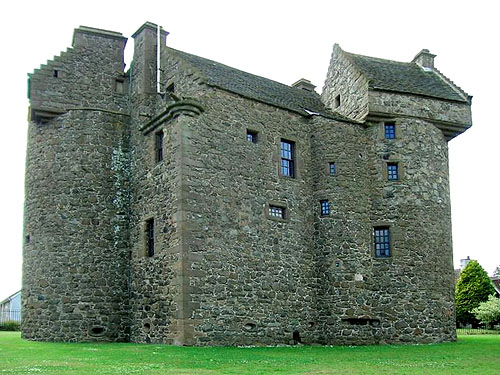 |
Claypotts Castle, Dundee, Scotland
Claypotts Castle is a late medieval castle in the suburban West Ferry area of Dundee, surrounded by modern housing.
Claypotts Castle is one of the best-preserved examples of a 16th-century 'Z-plan' tower house in Scotland.
The castle is maintained as an Ancient Monument by Historic Scotland. It is open to the public on a small number of days each year. |
||||||||
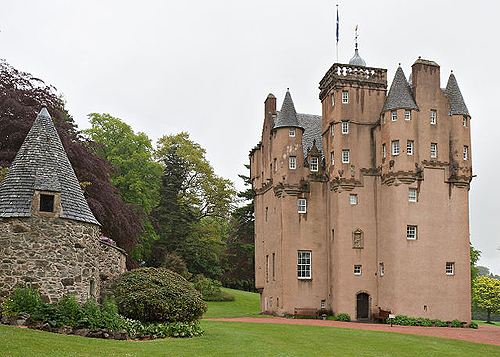 |
Craigievar Castle, south of Alford, Aberdeenshire, Scotland
Craigievar Castle is a pinki pigmented harled castle. It origibnally belonged to Mortimer family, but the Forbes family resided here for 350 years
Forbes purchased the partially completed structure from the impoverished Mortimer family in 1610. An example of the original Scottish Baronial architecture, the seven-storey castle was completed in 1626 by a merchant called William Forbes.
Designed in the L plan, Craigievar is noted for its plasterwork ceilings.
In 1963, the property was gifted to the National Trust for Scotland. |
||||||||
 |
Craigievar Castle south of Alford, Aberdeenshire, Scotland.
Craigievar Castle was the seat of Clan Sempill and the Forbes family who resided here for 350 years until 1963, when the property was given to the National Trust for Scotland.
An example of the original Scottish Baronial architecture, the seven-storey castle was completed in 1626 by the Aberdonian merchant William Forbes. Forbes purchased the partially completed structure from the Mortimer family in the year 1610. Designed in the L plan, Craigievar is noted for its exceptionally crafted plasterwork ceilings. The ceilings feature plaster figures of the Nine Worthies and other family emblems. |
||||||||
 |
Culzean Castle Maybole KA19 8LE Carrick Ayrshire Scotland
Culzean Castle is the former home of the Marquess of Ailsa, the chief of Clan Kennedy, but is now owned by the National Trust for Scotland. |
||||||||
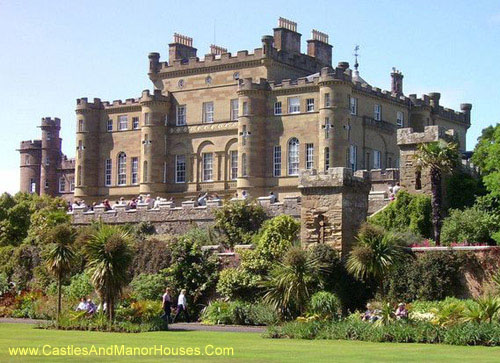 |
Culzean Castle near Maybole Carrick Ayrshire |
||||||||
 |
Dairsie Castle, Dairsie, north-east Fife, Scotland.
Dairsie Castle is a a restored tower house overlooking the River Eden. A Scottish parliament was held at the castle in early 1335.
The first castle built here was the property of the bishops of St Andrews, and was probably constructed by William de Lamberton, Bishop of St Andrews from 1298 to 1328. |
||||||||
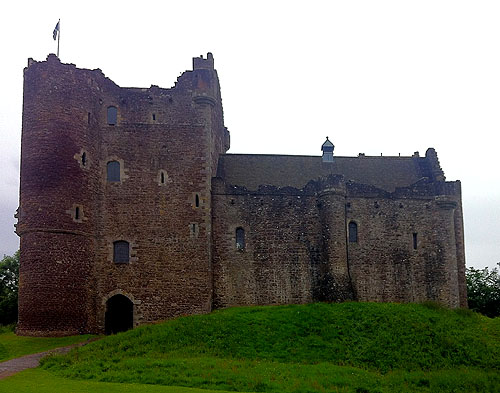 |
Doune Castle, Doune, Stirling district, central Scotland.
Doune Castle was originally built in the thirteenth century, then probably damaged in the Scottish Wars of Independence, before being rebuilt in its present form in the late 14th century by Robert Stewart, Duke of Albany (c.1340–1420), the son of King Robert II of Scotland, and Regent of Scotland from 1388 until his death.
Duke Robert's stronghold has survived relatively unchanged and complete. |
||||||||
 |
Drum Castle near Drumoak Aberdeenshire Scotland.
For centuries Drum Castle was the seat of the chief of Clan Irvine |
||||||||
 |
Drumlanrig Castle, Dumfries and Galloway, Scotland
The first Duke of Queensberry, William Douglas, had the The 'Pink Palace' of Drumlanrig built on the site of an ancient Douglas stronghold overlooking Nith Valley.
The castle was constructed between 1679 and 1689 from distinctive pink sandstone. It is an example of late 17th century Renaissance architecture.
The category A listed castle is the Dumfriesshire home of the Duke and Duchess of Buccleuch and Queensberry. |
||||||||
 |
Duart Castle, Isle of Mull, Argyll and Bute, Scotland
The castle dates back to the 13th century and is the seat of Clan MacLean. In 1350 Lachlan Lubanach Maclean of Duart, the 5th Clan Chief, married Mary, daughter of John of Islay, Lord of the Isles and she was given Duart as her dowry.
In 1678, Archibald Campbell, 9th Earl of Argyll, son of the Marquess of Argyll, invaded the Clan MacLean lands on the Isle of Mull and Sir John Maclean, 4th Baronet fled the castle and withdrew to Cairnbulg Castle. In 1691 Duart Castle was surrendered by Sir John Maclean, 4th Baronet to Archibald Campbell, 1st Duke of Argyll. The Campbells demolished the castle.
On September 11, 1911, the ruin was bought by Sir Fitzroy Donald Maclean, the 26th Chief of the Clan MacLean and has since been restored. |
||||||||
 |
Dunnottar, Aberdeenshire, Scotland
Dunnottar Castle is a ruined medieval fortress located on a rocky headland on the north-east coast of Scotland, about 3 kilometres (1.9 mi) south of Stonehaven.
The property of the Keiths from the 14th century, and the seat of the Earl Marischal, Dunnottar declined after the last Earl forfeited his titles by taking part in the Jacobite rebellion of 1715. Surviving buildings are largely of the 15th and 16th centuries.
Dunnottar has played a prominent role in the history of Scotland because of its strategic location and the strength of its position. It is best known as the place where the Honours of Scotland, the Scottish crown jewels, were hidden from Oliver Cromwell's invading army in the 17th century.
Dunnottar Castle was restored in the 20th century and is now open to the public. It is a scheduled monument. Twelve structures on the site are listed buildings. |
||||||||
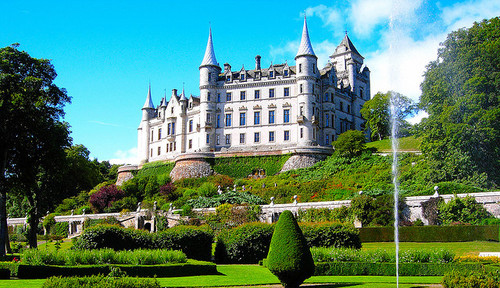 |
Dunrobin Castle, Sutherland, Highland, Scotland
Dunrobin Castle is a stately home, and the family seat of the Earl of Sutherland and the Clan Sutherland.
Dunrobin's origins lie in the Middle Ages, but most of the present building is the work of Sir Charles Barry, who greatly extended the building in 1845.
Some of the original building is visible in the interior courtyard. |
||||||||
 |
Dunrobin Castle north of Golspie, Highland area, Scotland
Dunrobin Castle is a stately homeand the family seat of the Earl of Sutherland and the Clan Sutherlan, overlooking the Dornoch Firth .
During the Rising of 1745, Jacobites under Charles Edward Stuart stormed Dunrobin Castle without warning, because the Clan Sutherland supported the British government. The 17th Earl of Sutherland, who had changed his surname from Gordon to Sutherland, narrowly escaped them, leaving through a back door. He sailed for Aberdeen where he joined the Duke of Cumberland's army.
Dunrobin's origins lie in the Middle Ages, but most of the present building and the gardens was added by Sir Charles Barry between 1835 and 1850. Some of the original building is visible in the interior courtyard, despite a number of expansions and alterations. There are 189 rooms within the castle, making it the largest in the northern Highlands
It is now open to the public. Falconry displays are held in the castle's gardens by a resident Falconer. |
||||||||
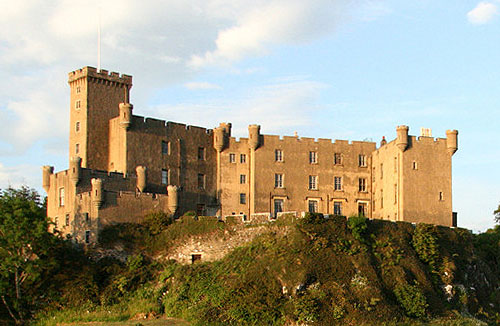 |
Dunvegan Castle, Isle of Skye, Scotland
Dunvegan Castle is the seat of the MacLeod of MacLeod, chief of the Clan MacLeod.
Dunvegan Castle is the oldest continuously inhabited castle in Scotland and has been the stronghold of the chiefs of the MacLeod clan for 800 years. |
||||||||
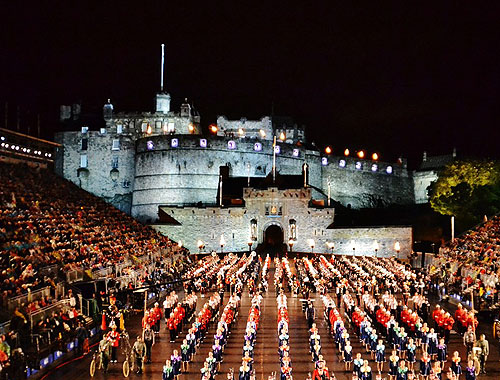 |
Edinburgh Castle, Edinburgh, Scotland
Edinburgh Castle is an historic fortress which dominates the skyline of the city of Edinburgh from its position on the Castle Rock. Archaeologists have established human occupation of the rock since at least the 2nd century AD. There has been a royal castle on the rock since at least the reign of David I in the 12th century, and the site continued to be a royal residence until the Union of the Crowns in 1603.
As one of the most important strongholds in the Kingdom of Scotland, Edinburgh Castle was involved in many historical conflicts from the Wars of Scottish Independence in the 14th century to the Jacobite Rising of 1745.
The castle houses the Scottish regalia, known as the Honours of Scotland and is the site of the Scottish National War Memorial and the National War Museum of Scotland.
The castle is in the care of Historic Scotland and is Scotland's most-visited paid tourist attraction. The British Army is still responsible for some parts of the castle, although its presence is now largely ceremonial and administrative. |
||||||||
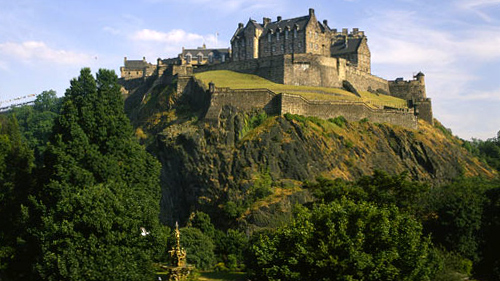 |
Edinburgh Castle, Edinburgh, Scotland
Edinburgh Castle is an historic fortress which dominates the skyline of the city of Edinburgh from its position on the Castle Rock. Archaeologists have established human occupation of the rock since at least the 2nd century AD. There has been a royal castle on the rock since at least the reign of David I in the 12th century, and the site continued to be a royal residence until the Union of the Crowns in 1603.
As one of the most important strongholds in the Kingdom of Scotland, Edinburgh Castle was involved in many historical conflicts from the Wars of Scottish Independence in the 14th century to the Jacobite Rising of 1745.
The castle houses the Scottish regalia, known as the Honours of Scotland and is the site of the Scottish National War Memorial and the National War Museum of Scotland.
The castle is in the care of Historic Scotland and is Scotland's most-visited paid tourist attraction. The British Army is still responsible for some parts of the castle, although its presence is now largely ceremonial and administrative. |
||||||||
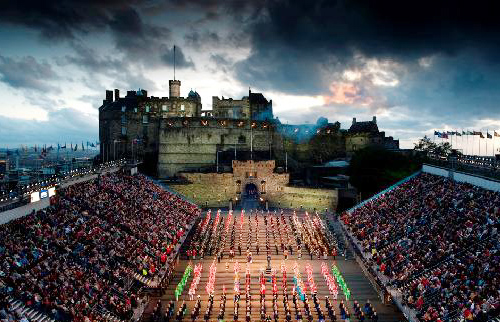 |
Edinburgh Castle, Edinburgh, Scotland
Edinburgh Castle is an historic fortress which dominates the skyline of the city of Edinburgh from its position on the Castle Rock. Archaeologists have established human occupation of the rock since at least the 2nd century AD. There has been a royal castle on the rock since at least the reign of David I in the 12th century, and the site continued to be a royal residence until the Union of the Crowns in 1603.
As one of the most important strongholds in the Kingdom of Scotland, Edinburgh Castle was involved in many historical conflicts from the Wars of Scottish Independence in the 14th century to the Jacobite Rising of 1745.
The castle houses the Scottish regalia, known as the Honours of Scotland and is the site of the Scottish National War Memorial and the National War Museum of Scotland.
The castle is in the care of Historic Scotland and is Scotland's most-visited paid tourist attraction. The British Army is still responsible for some parts of the castle, although its presence is now largely ceremonial and administrative. |
||||||||
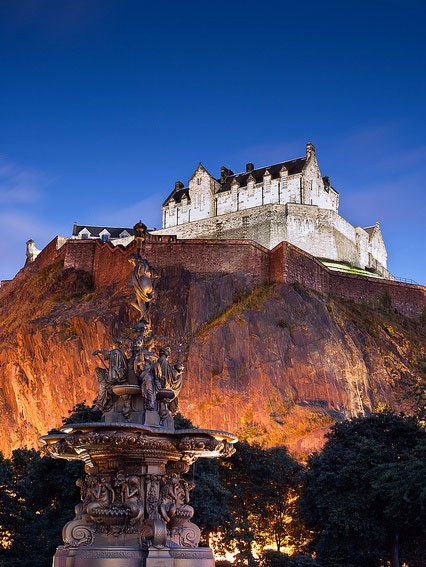 |
Edinburgh Castle, Castle Rock, Edinburgh, Scotland
Edinburgh Castle is a historic fortress diminating the skyline of the city of Edinburgh. There has been a royal castle on the rock since at least the reign of David I in the 12th century.
As one of the most important strongholds in the Kingdom of Scotland, Edinburgh Castle was involved in many historical conflicts from the Wars of Scottish Independence in the 14th century to the Jacobite Rising of 1745.
The castle houses the Scottish regalia, known as the Honours of Scotland and is the site of the Scottish National War Memorial and the National War Museum of Scotland. The British Army is still responsible for some parts of the castle.
The castle is in the care of Historic Scotland and is Scotland's most-visited paid tourist attraction. As the backdrop to the Edinburgh Military Tattoo during the annual Edinburgh International Festival the castle has become a recognisable symbol of Edinburgh and of Scotland. |
||||||||
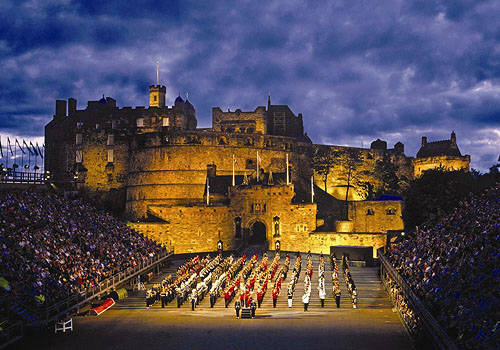 |
Edinburgh Castle, Edinburgh, Scotland
Edinburgh Castle is an historic fortress which dominates the skyline of the city of Edinburgh from its position on the Castle Rock. Archaeologists have established human occupation of the rock since at least the 2nd century AD. There has been a royal castle on the rock since at least the reign of David I in the 12th century, and the site continued to be a royal residence until the Union of the Crowns in 1603.
As one of the most important strongholds in the Kingdom of Scotland, Edinburgh Castle was involved in many historical conflicts from the Wars of Scottish Independence in the 14th century to the Jacobite Rising of 1745.
The castle houses the Scottish regalia, known as the Honours of Scotland and is the site of the Scottish National War Memorial and the National War Museum of Scotland.
The castle is in the care of Historic Scotland and is Scotland's most-visited paid tourist attraction. The British Army is still responsible for some parts of the castle, although its presence is now largely ceremonial and administrative. |
||||||||
 |
Edinburgh Castle Castle Rock, Edinburgh, Scotland
Edinburgh Castle is a historic fortress dominating the skyline of the city of Edinburgh. There has been a royal castle on the rock since at least the reign of David I in the 12th century.
As one of the most important strongholds in the Kingdom of Scotland, Edinburgh Castle was involved in many historical conflicts from the Wars of Scottish Independence in the 14th century to the Jacobite Rising of 1745.
The castle houses the Scottish regalia, known as the Honours of Scotland and is the site of the Scottish National War Memorial and the National War Museum of Scotland. The British Army is still responsible for parts of the castle.
The castle is now in the care of Historic Scotland and is Scotland's most-visited paid tourist attraction. As the backdrop to the Edinburgh Military Tattoo during the annual Edinburgh International Festival the castle has become a recognisable symbol of Edinburgh and of Scotland. |
||||||||
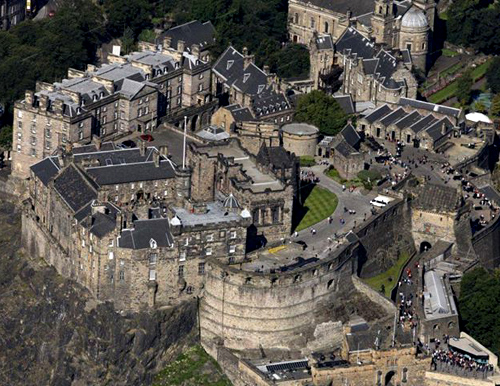 |
Edinburgh Castle, Edinburgh, Scotland
Edinburgh Castle is an historic fortress which dominates the skyline of the city of Edinburgh from its position on the Castle Rock. Archaeologists have established human occupation of the rock since at least the 2nd century AD. There has been a royal castle on the rock since at least the reign of David I in the 12th century, and the site continued to be a royal residence until the Union of the Crowns in 1603.
As one of the most important strongholds in the Kingdom of Scotland, Edinburgh Castle was involved in many historical conflicts from the Wars of Scottish Independence in the 14th century to the Jacobite Rising of 1745.
The castle houses the Scottish regalia, known as the Honours of Scotland and is the site of the Scottish National War Memorial and the National War Museum of Scotland.
The castle is in the care of Historic Scotland and is Scotland's most-visited paid tourist attraction. The British Army is still responsible for some parts of the castle, although its presence is now largely ceremonial and administrative. |
||||||||
 |
Edinburgh Castle, Edinburgh, Scotland
Edinburgh Castle is an historic fortress which dominates the skyline of the city of Edinburgh from its position on the Castle Rock. Archaeologists have established human occupation of the rock since at least the 2nd century AD. There has been a royal castle on the rock since at least the reign of David I in the 12th century, and the site continued to be a royal residence until the Union of the Crowns in 1603.
As one of the most important strongholds in the Kingdom of Scotland, Edinburgh Castle was involved in many historical conflicts from the Wars of Scottish Independence in the 14th century to the Jacobite Rising of 1745.
The castle houses the Scottish regalia, known as the Honours of Scotland and is the site of the Scottish National War Memorial and the National War Museum of Scotland.
The castle is in the care of Historic Scotland and is Scotland's most-visited paid tourist attraction. The British Army is still responsible for some parts of the castle, although its presence is now largely ceremonial and administrative. |
||||||||
 |
Edinburgh Castle, Castle Rock, Edinburgh, Scotland
Edinburgh Castle is a historic fortress diminating the skyline of the city of Edinburgh. There has been a royal castle on the rock since at least the reign of David I in the 12th century.
As one of the most important strongholds in the Kingdom of Scotland, Edinburgh Castle was involved in many historical conflicts from the Wars of Scottish Independence in the 14th century to the Jacobite Rising of 1745.
The castle houses the Scottish regalia, known as the Honours of Scotland and is the site of the Scottish National War Memorial and the National War Museum of Scotland. The British Army is still responsible for some parts of the castle.
The castle is in the care of Historic Scotland and is Scotland's most-visited paid tourist attraction. As the backdrop to the Edinburgh Military Tattoo during the annual Edinburgh International Festival the castle has become a recognisable symbol of Edinburgh and of Scotland. |
||||||||
 |
Edinburgh Castle Edinburgh Scotland |
||||||||
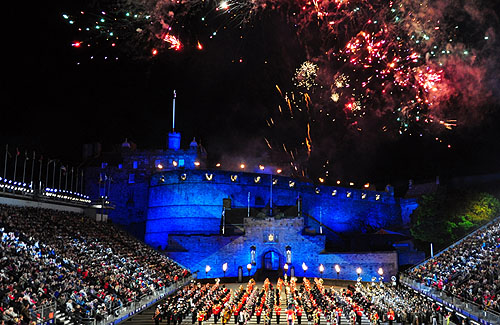 |
Edinburgh Castle, Edinburgh, Scotland
Edinburgh Castle is an historic fortress which dominates the skyline of the city of Edinburgh from its position on the Castle Rock. Archaeologists have established human occupation of the rock since at least the 2nd century AD. There has been a royal castle on the rock since at least the reign of David I in the 12th century, and the site continued to be a royal residence until the Union of the Crowns in 1603.
As one of the most important strongholds in the Kingdom of Scotland, Edinburgh Castle was involved in many historical conflicts from the Wars of Scottish Independence in the 14th century to the Jacobite Rising of 1745.
The castle houses the Scottish regalia, known as the Honours of Scotland and is the site of the Scottish National War Memorial and the National War Museum of Scotland.
The castle is in the care of Historic Scotland and is Scotland's most-visited paid tourist attraction. The British Army is still responsible for some parts of the castle, although its presence is now largely ceremonial and administrative. |
||||||||
 |
Edinburgh Castle, Edinburgh, Scotland
Edinburgh Castle is an historic fortress which dominates the skyline of the city of Edinburgh from its position on the Castle Rock. Archaeologists have established human occupation of the rock since at least the 2nd century AD. There has been a royal castle on the rock since at least the reign of David I in the 12th century, and the site continued to be a royal residence until the Union of the Crowns in 1603.
As one of the most important strongholds in the Kingdom of Scotland, Edinburgh Castle was involved in many historical conflicts from the Wars of Scottish Independence in the 14th century to the Jacobite Rising of 1745.
The castle houses the Scottish regalia, known as the Honours of Scotland and is the site of the Scottish National War Memorial and the National War Museum of Scotland.
The castle is in the care of Historic Scotland and is Scotland's most-visited paid tourist attraction. The British Army is still responsible for some parts of the castle, although its presence is now largely ceremonial and administrative. |
||||||||
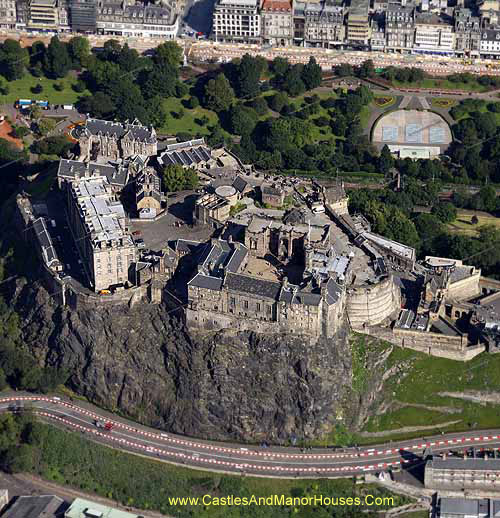 |
Edinburgh Castle Castle Rock, Edinburgh, Scotland
Edinburgh Castle is a historic fortress diminating the skyline of the city of Edinburgh. There has been a royal castle on the rock since at least the reign of David I in the 12th century.
As one of the most important strongholds in the Kingdom of Scotland, Edinburgh Castle was involved in many historical conflicts from the Wars of Scottish Independence in the 14th century to the Jacobite Rising of 1745.
The castle houses the Scottish regalia, known as the Honours of Scotland and is the site of the Scottish National War Memorial and the National War Museum of Scotland. The British Army is still responsible for some parts of the castle.
The castle is in the care of Historic Scotland and is Scotland's most-visited paid tourist attraction. As the backdrop to the Edinburgh Military Tattoo during the annual Edinburgh International Festival the castle has become a recognisable symbol of Edinburgh and of Scotland. |
||||||||
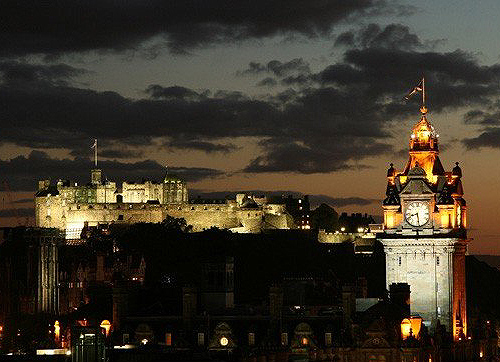 |
Edinburgh Castle, Edinburgh, Scotland
Edinburgh Castle is an historic fortress which dominates the skyline of the city of Edinburgh from its position on the Castle Rock. Archaeologists have established human occupation of the rock since at least the 2nd century AD. There has been a royal castle on the rock since at least the reign of David I in the 12th century, and the site continued to be a royal residence until the Union of the Crowns in 1603.
As one of the most important strongholds in the Kingdom of Scotland, Edinburgh Castle was involved in many historical conflicts from the Wars of Scottish Independence in the 14th century to the Jacobite Rising of 1745.
The castle houses the Scottish regalia, known as the Honours of Scotland and is the site of the Scottish National War Memorial and the National War Museum of Scotland.
The castle is in the care of Historic Scotland and is Scotland's most-visited paid tourist attraction. The British Army is still responsible for some parts of the castle, although its presence is now largely ceremonial and administrative. |
||||||||
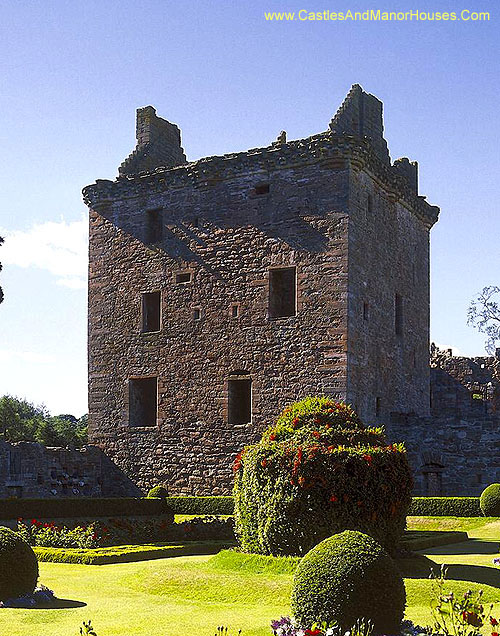 |
Edzell Castle near Edzell, Angus, Scotland
Edzell Castle is a ruined 16th-century castle, with an early-17th-century walled garden. Edzell Castle was begun around 1520 by David Lindsay, 9th Earl of Crawford, and expanded by his son, Sir David Lindsay, Lord Edzell, who also laid out the garden in 1604.
It was briefly occupied by English troops during Oliver Cromwell's invasion of Scotland in 1651. In 1715 it was sold by the Lindsay family, and eventually came into the ownership of the Earl of Dalhousie.
The castle consists of the original tower house and building ranges around a courtyard. The adjacent Renaissance walled garden was replanted in the 1930s.
Edzell Castle was given into state care in the 1930s, and is now a visitor attraction run by Historic Scotland. |
||||||||
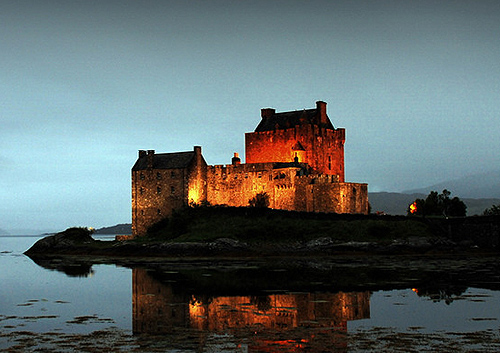 |
Eilean Donan Castle, Eilean Donan Island, Scotland
Eilean Donan is a small tidal island in Loch Duich in the western Highlands of Scotland, which lies about 1 kilometre (0.62 mi) from the village of Dornie. It appears frequently in photographs, film and television.
The castle was founded in the thirteenth century, and became a stronghold of the Clan Mackenzie and their allies the Clan Macrae. In the early eighteenth century the Mackenzies' involvement in the Jacobite rebellions led in 1719 to the castle's destruction by government ships. Lieutenant-Colonel John Macrae-Gilstrap's twentieth-century reconstruction of the ruins produced the present buildings. Since the castle's restoration, a footbridge has connected the island to the Scottish mainland.
Eilean Donan is part of the Kintail National Scenic Area |
||||||||
 |
Eilean Donan Castle, Eilean Donan Island, Scotland
Eilean Donan is a small tidal island in Loch Duich in the western Highlands of Scotland, which lies about 1 kilometre (0.62 mi) from the village of Dornie. It appears frequently in photographs, film and television.
The castle was founded in the thirteenth century, and became a stronghold of the Clan Mackenzie and their allies the Clan Macrae. In the early eighteenth century the Mackenzies' involvement in the Jacobite rebellions led in 1719 to the castle's destruction by government ships. Lieutenant-Colonel John Macrae-Gilstrap's twentieth-century reconstruction of the ruins produced the present buildings. Since the castle's restoration, a footbridge has connected the island to the Scottish mainland.
Eilean Donan is part of the Kintail National Scenic Area |
||||||||
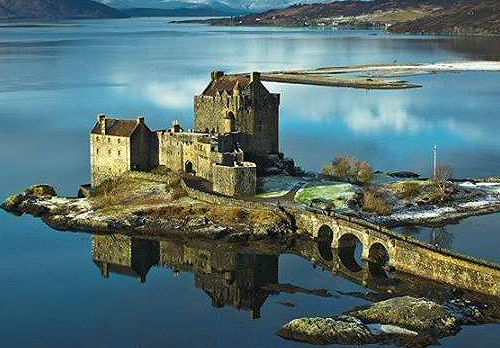 |
Eilean Donan Castle, Eilean Donan Island, Scotland
Eilean Donan is a small tidal island in Loch Duich in the western Highlands of Scotland, which lies about 1 kilometre (0.62 mi) from the village of Dornie. It appears frequently in photographs, film and television.
The castle was founded in the thirteenth century, and became a stronghold of the Clan Mackenzie and their allies the Clan Macrae. In the early eighteenth century the Mackenzies' involvement in the Jacobite rebellions led in 1719 to the castle's destruction by government ships. Lieutenant-Colonel John Macrae-Gilstrap's twentieth-century reconstruction of the ruins produced the present buildings. Since the castle's restoration, a footbridge has connected the island to the Scottish mainland.
Eilean Donan is part of the Kintail National Scenic Area |
||||||||
 |
Eilean Donan (Eilean Donnain) Dornie, Kyle of Lochalsh IV40 8DX, Scotland
Eilean Donan is a castle and small tidal island where three lochs meet, Loch Duich, Loch Long and Loch Alsh, in the western Highlands of Scotland.
The castle was founded in the thirteenth century, and became a stronghold of the Clan Mackenzie and their allies the Clan Macrae.
Between 1919 and 1932 the castle was rebuilt by Lt. Col. John MacRae-Gilstrap. The restoration included the construction of an arched bridge to give easier access to the island.
|
||||||||
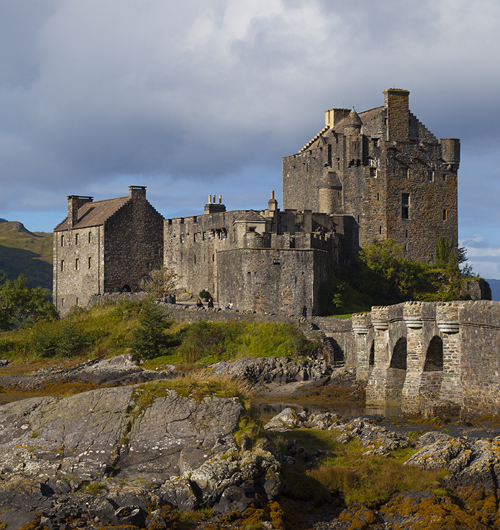 |
Eilean Donan (Eilean Donnain) Dornie, Kyle of Lochalsh IV40 8DX, Scotland
Eilean Donan is a castle and small tidal island where three lochs meet, Loch Duich, Loch Long and Loch Alsh, in the western Highlands of Scotland.
The castle was founded in the thirteenth century, and became a stronghold of the Clan Mackenzie and their allies the Clan Macrae.
Between 1919 and 1932 the castle was rebuilt by Lt. Col. John MacRae-Gilstrap. The restoration included the construction of an arched bridge to give easier access to the island.
|
||||||||
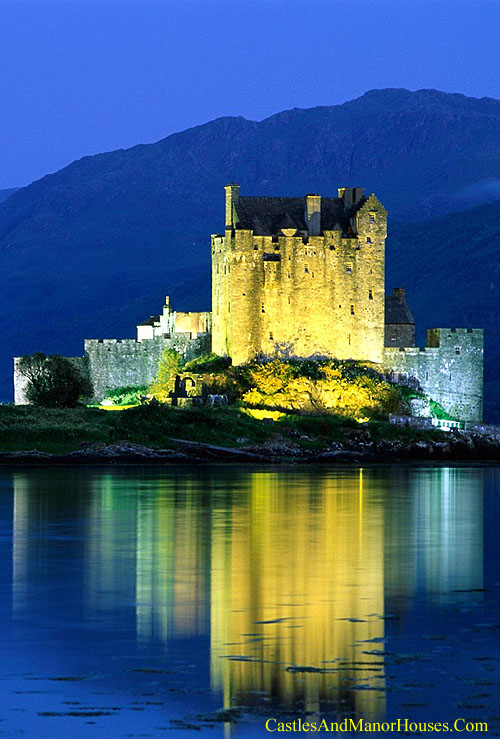 |
Eilean Donan (Eilean Donnain) Dornie, Kyle of Lochalsh IV40 8DX, Scotland
Eilean Donan is a castle and small tidal island where three lochs meet, Loch Duich, Loch Long and Loch Alsh, in the western Highlands of Scotland.
The castle was founded in the thirteenth century, and became a stronghold of the Clan Mackenzie and their allies the Clan Macrae.
Between 1919 and 1932 the castle was rebuilt by Lt. Col. John MacRae-Gilstrap. The restoration included the construction of an arched bridge to give easier access to the island.
|
||||||||
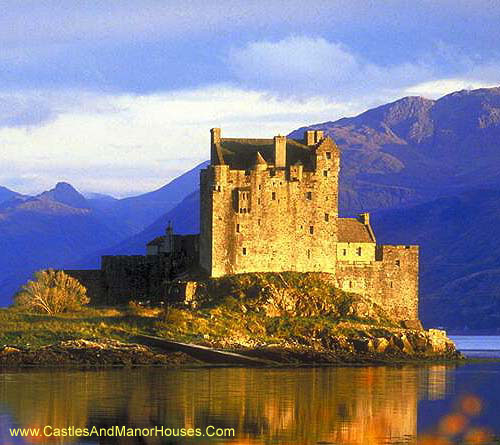 |
Eilean Donan (Eilean Donnain) Dornie, Kyle of Lochalsh IV40 8DX, Scotland
Eilean Donan is a castle and small tidal island where three lochs meet, Loch Duich, Loch Long and Loch Alsh, in the western Highlands of Scotland.
The castle was founded in the thirteenth century, and became a stronghold of the Clan Mackenzie and their allies the Clan Macrae.
Between 1919 and 1932 the castle was rebuilt by Lt. Col. John MacRae-Gilstrap. The restoration included the construction of an arched bridge to give easier access to the island. |
||||||||
 |
Eilean Donan (Eilean Donnain) Dornie, Kyle of Lochalsh IV40 8DX, Scotland
Eilean Donan is a castle and small tidal island where three lochs meet, Loch Duich, Loch Long and Loch Alsh, in the western Highlands of Scotland.
The castle was founded in the thirteenth century, and became a stronghold of the Clan Mackenzie and their allies the Clan Macrae.
Between 1919 and 1932 the castle was rebuilt by Lt. Col. John MacRae-Gilstrap. The restoration included the construction of an arched bridge to give easier access to the island.
|
||||||||
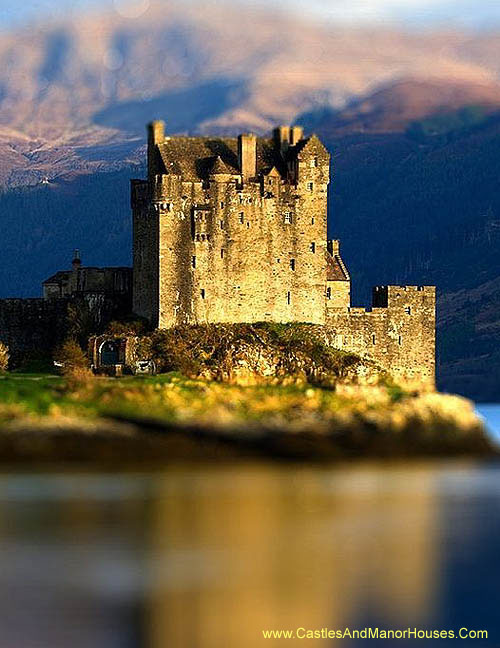 |
Eilean Donan (Eilean Donnain) Dornie, Kyle of Lochalsh IV40 8DX, Scotland
Eilean Donan is a castle and small tidal island where three lochs meet, Loch Duich, Loch Long and Loch Alsh, in the western Highlands of Scotland.
The castle was founded in the thirteenth century, and became a stronghold of the Clan Mackenzie and their allies the Clan Macrae.
Between 1919 and 1932 the castle was rebuilt by Lt. Col. John MacRae-Gilstrap. The restoration included the construction of an arched bridge to give easier access to the island. |
||||||||
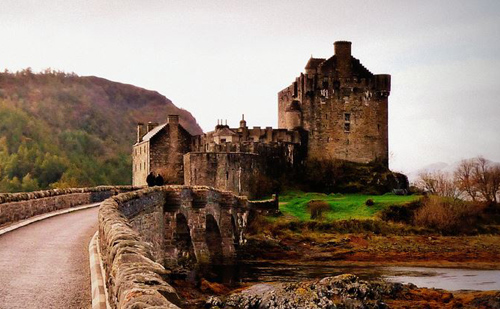 |
Eilean Donan Castle, Eilean Donan Island, Scotland
Eilean Donan is a small tidal island in Loch Duich in the western Highlands of Scotland, which lies about 1 kilometre (0.62 mi) from the village of Dornie. It appears frequently in photographs, film and television.
The castle was founded in the thirteenth century, and became a stronghold of the Clan Mackenzie and their allies the Clan Macrae. In the early eighteenth century the Mackenzies' involvement in the Jacobite rebellions led in 1719 to the castle's destruction by government ships. Lieutenant-Colonel John Macrae-Gilstrap's twentieth-century reconstruction of the ruins produced the present buildings. Since the castle's restoration, a footbridge has connected the island to the Scottish mainland.
Eilean Donan is part of the Kintail National Scenic Area |
||||||||
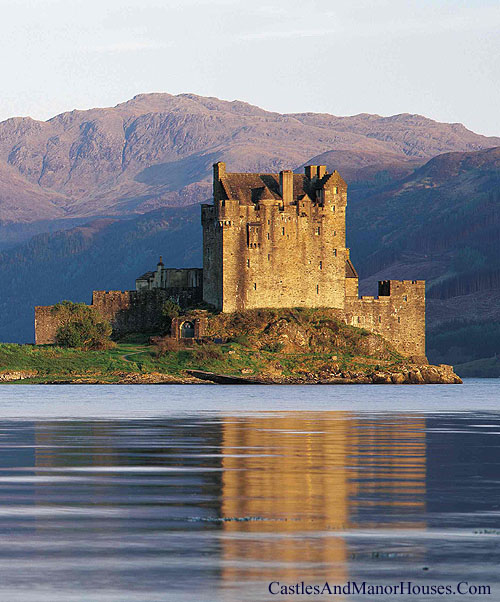 |
Eilean Donan (Eilean Donnain) Dornie, Kyle of Lochalsh IV40 8DX, Scotland
Eilean Donan is a castle and small tidal island where three lochs meet, Loch Duich, Loch Long and Loch Alsh, in the western Highlands of Scotland.
The castle was founded in the thirteenth century, and became a stronghold of the Clan Mackenzie and their allies the Clan Macrae.
Between 1919 and 1932 the castle was rebuilt by Lt. Col. John MacRae-Gilstrap. The restoration included the construction of an arched bridge to give easier access to the island.
|
||||||||
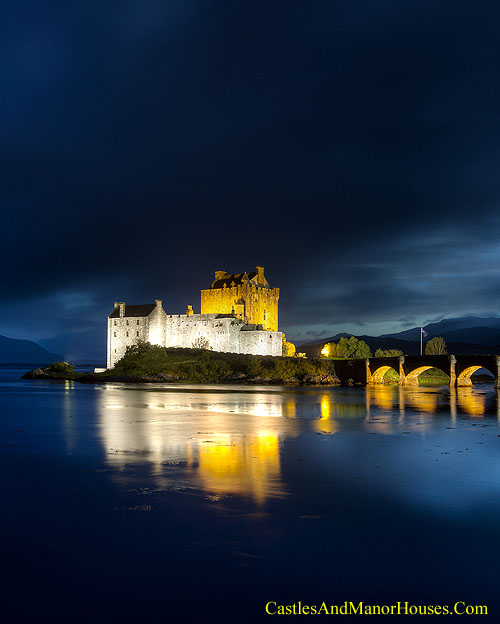 |
Eilean Donan (Eilean Donnain) Dornie, Kyle of Lochalsh IV40 8DX, Scotland
Eilean Donan is a castle and small tidal island where three lochs meet, Loch Duich, Loch Long and Loch Alsh, in the western Highlands of Scotland.
The castle was founded in the thirteenth century, and became a stronghold of the Clan Mackenzie and their allies the Clan Macrae.
Between 1919 and 1932 the castle was rebuilt by Lt. Col. John MacRae-Gilstrap. The restoration included the construction of an arched bridge to give easier access to the island.
|
||||||||
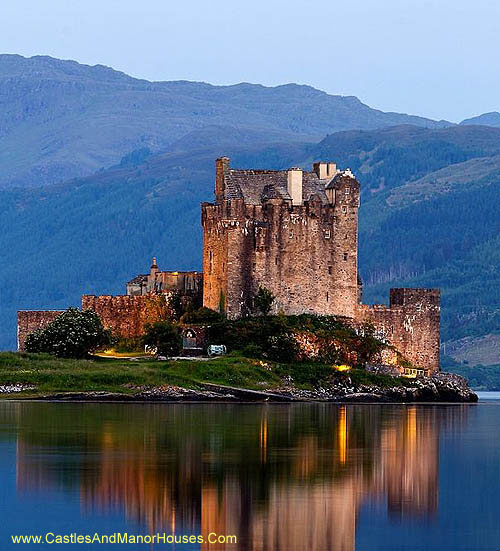 |
Eilean Donan (Eilean Donnain) Dornie, Kyle of Lochalsh IV40 8DX, Scotland
Eilean Donan is a castle and small tidal island where three lochs meet, Loch Duich, Loch Long and Loch Alsh, in the western Highlands of Scotland.
The castle was founded in the thirteenth century, and became a stronghold of the Clan Mackenzie and their allies the Clan Macrae.
Between 1919 and 1932 the castle was rebuilt by Lt. Col. John MacRae-Gilstrap. The restoration included the construction of an arched bridge to give easier access to the island. |
||||||||
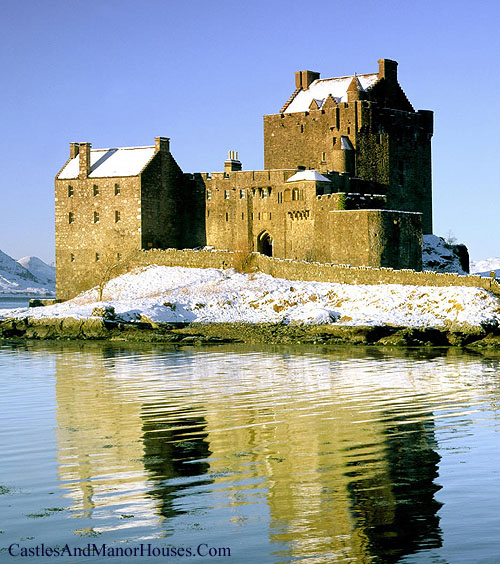 |
Eilean Donan (Eilean Donnain) Dornie, Kyle of Lochalsh IV40 8DX, Scotland
Eilean Donan is a castle and small tidal island where three lochs meet, Loch Duich, Loch Long and Loch Alsh, in the western Highlands of Scotland.
The castle was founded in the thirteenth century, and became a stronghold of the Clan Mackenzie and their allies the Clan Macrae.
Between 1919 and 1932 the castle was rebuilt by Lt. Col. John MacRae-Gilstrap. The restoration included the construction of an arched bridge to give easier access to the island.
|
||||||||
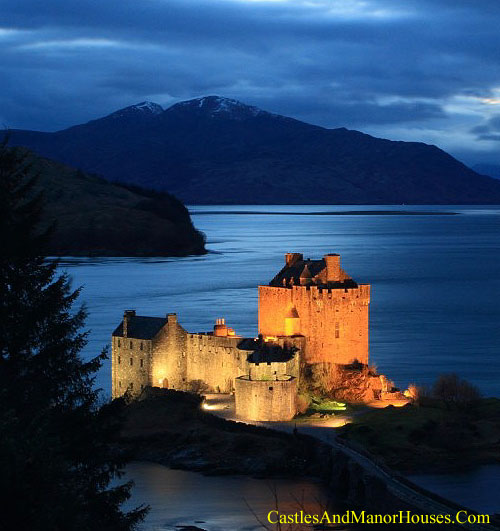 |
Eilean Donan (Eilean Donnain) Dornie, Kyle of Lochalsh IV40 8DX, Scotland
Eilean Donan is a castle and small tidal island where three lochs meet, Loch Duich, Loch Long and Loch Alsh, in the western Highlands of Scotland.
The castle was founded in the thirteenth century, and became a stronghold of the Clan Mackenzie and their allies the Clan Macrae.
Between 1919 and 1932 the castle was rebuilt by Lt. Col. John MacRae-Gilstrap. The restoration included the construction of an arched bridge to give easier access to the island. |
||||||||
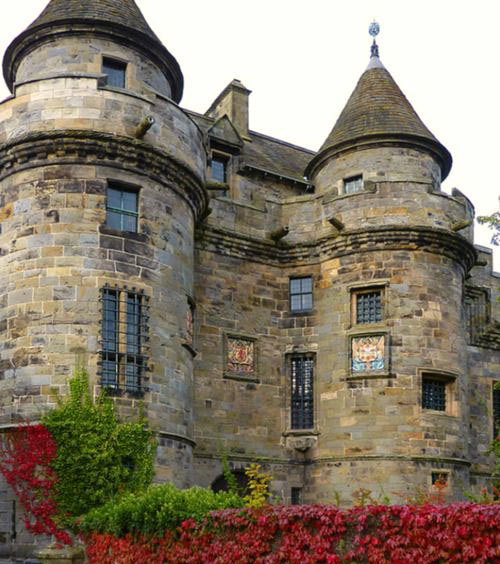 |
Falkland Palace, Falkland, Fife, Scotland
Falkland Palace is a former royal palace of the Scottish Kings.
The Scottish Crown acquired Falkland Castle from MacDuff of Fife in the 14th century. In 1402 Robert Stewart, 1st Duke of Albany imprisoned his nephew David Stewart, Duke of Rothesay, the eldest son of King Robert III of Scotland, at Falkland. The incarcerated Duke eventually died here from neglect and starvation.
Falkland Palace has been in the keepership of the Crichton Stuart family since its acquisition by the 3rd Marquess of Bute in 1887. In 1952, the 5th Marquess of Bute appointed the National Trust for Scotland in 1952 as Deputy Keeper of the Palace to take care of ithe building and its extensive gardens. Today it serves as a tourist attraction.
|
||||||||
 |
Forter Castle, Kirkton Of Glenisla, Perthshire PH11 8QW, Scotland
Forter Castle was built by the Ogilvys of Airlie
as a fortified |
||||||||
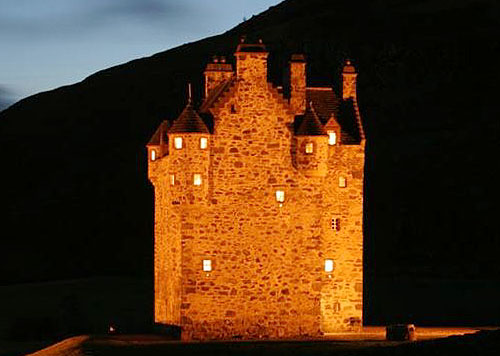 |
Forter Castle, Kirkton Of Glenisla, Perthshire PH11 8QW, Scotland
Forter Castle was built by the Ogilvys of Airlie
as a fortified |
||||||||
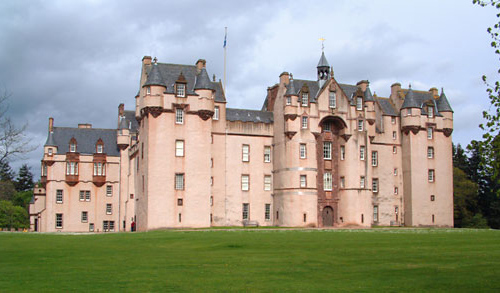 |
Fyvie Castle. Fyvie, near Turriff, Aberdeenshire, Scotland.
The earliest parts of Fyvie Castle date from the 13th century. Fyvie was the site of an open-air court held by Robert the Bruce, and Charles I lived there as a child. Following the Battle of Otterburn in 1390, it ceased to be a royal stronghold and fell into the possession of five successive families - Preston, Meldrum, Seton, Gordon and Leith - each of whom added a new tower to the castle.
The Scottish industrialist Alexander Leith (later Baron Leith of Fyvie) bought the castle in 1885. It was sold to the National Trust for Scotland in 1984 by his descendants.
Today, the castle is open to tourists during the summer months. |
||||||||
 |
Fyvie Castle Fyvie, near Turriff, Aberdeenshire, Scotland.
The earliest parts of Fyvie Castle date from the 13th century - some sources claim it was built in 1211 by William the Lion. Fyvie was the site of an open-air court held by Robert the Bruce. Charles I lived there as a child.
Inside, the castle stronghold features a great wheel stair, a display of original arms and armour, and a collection of portraits.
The Scottish industrialist Alexander Leith (later Baron Leith of Fyvie) bought the castle in 1885. It was sold to the National Trust for Scotland by his descendants in 1984. |
||||||||
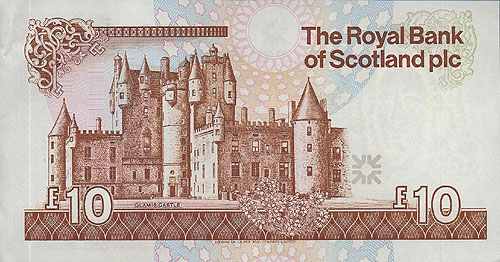 |
Glamis Castle is situated beside the village of Glamis, in Angus, Scotland.
It is the home of the Earl and Countess of Strathmore and Kinghorne, and is open to the public.
Glamis Castle has been the home of the Lyon family since the 14th century, though the present building dates largely from the 17th century. Glamis was the childhood home of Queen Elizabeth The Queen Mother, wife of King George VI. Their second daughter, Princess Margaret, Countess of Snowdon, was born there.
The castle is protected as a category A listed building, and the grounds are included on the Inventory of Gardens and Designed Landscapes in Scotland, the national listing of significant gardens. |
||||||||
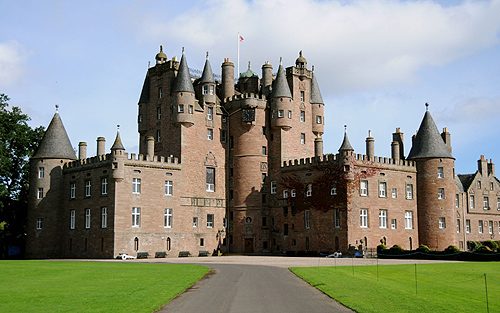 |
Glamis Castle, Angus DD8 1RJ, Scotland
Glamis Castle has been the home of the Lyon family since the 14th century, though the present building dates largely from the 17th century. Glamis was the childhood home of Elizabeth Bowes-Lyon, who married King George VI, (Queen Elizabeth, later, Queen Elizabeth The Queen Mother). Her second daughter, Princess Margaret, was born there.
Glamis Castle is still home to the Earl and Countess of Strathmore and Kinghorne.
The castle is protected as a category A listed building, and the grounds are included on the Inventory of Gardens and Designed Landscapes in Scotland, the national listing of significant gardens. It is open to the public. |
||||||||
 |
Glamis Castle, situated beside the village of Glamis, in Angus, Scotland.
It is the home of the Earl and Countess of Strathmore and Kinghorne, and is open to the public. It has been the home of the Lyon family since the 14th century, though the present building dates largely from the 17th century. Glamis was the childhood home of Queen Elizabeth The Queen Mother, wife of King George VI. Their second daughter, Princess Margaret, Countess of Snowdon, was born there.
The castle is protected as a category A listed building, and the grounds are included on the Inventory of Gardens and Designed Landscapes in Scotland, the national listing of significant gardens. |
||||||||
 |
Glamis Castle, Angus DD8 1RJ, Scotland
Glamis Castle has been the home of the Lyon family since the 14th century, though the present building dates largely from the 17th century. Glamis was the childhood home of Elizabeth Bowes-Lyon, who married King George VI, (Queen Elizabeth, later, Queen Elizabeth The Queen Mother). Her second daughter, Princess Margaret, was born there.
Glamis Castle is still home to the Earl and Countess of Strathmore and Kinghorne.
The castle is protected as a category A listed building, and the grounds are included on the Inventory of Gardens and Designed Landscapes in Scotland, the national listing of significant gardens. It is open to the public. |
||||||||
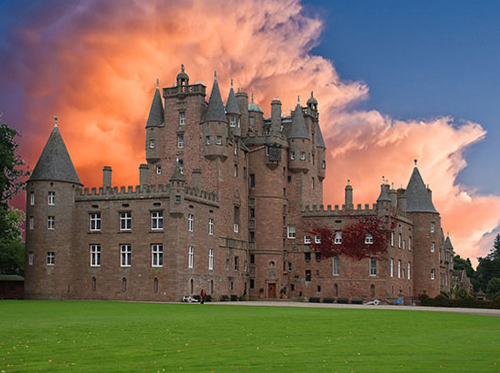 |
Glamis Castle, Angus DD8 1RJ, Scotland
Glamis Castle has been the home of the Lyon family since the 14th century, though the present building dates largely from the 17th century. Glamis was the childhood home of Elizabeth Bowes-Lyon, who married King George VI, (Queen Elizabeth, later, Queen Elizabeth The Queen Mother). Her second daughter, Princess Margaret, was born there.
Glamis Castle is still home to the Earl and Countess of Strathmore and Kinghorne.
The castle is protected as a category A listed building, and the grounds are included on the Inventory of Gardens and Designed Landscapes in Scotland, the national listing of significant gardens. It is open to the public. |
||||||||
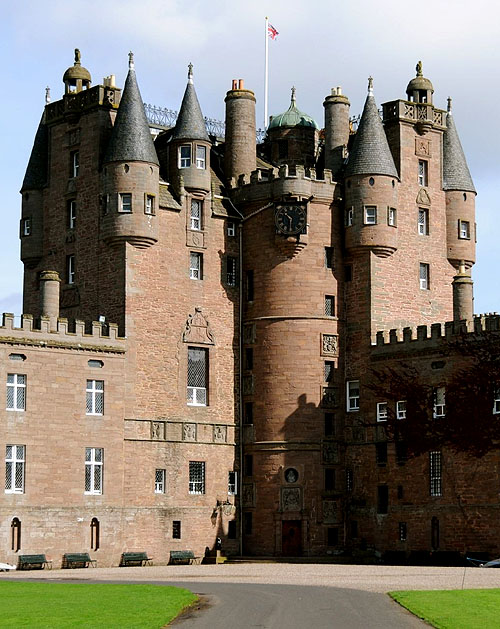 |
Glamis Castle, Angus DD8 1RJ, Scotland
Glamis Castle has been the home of the Lyon family since the 14th century, though the present building dates largely from the 17th century. Glamis was the childhood home of Elizabeth Bowes-Lyon, who married King George VI, (Queen Elizabeth, later, Queen Elizabeth The Queen Mother). Her second daughter, Princess Margaret, was born there.
Glamis Castle is still home to the Earl and Countess of Strathmore and Kinghorne.
The castle is protected as a category A listed building, and the grounds are included on the Inventory of Gardens and Designed Landscapes in Scotland, the national listing of significant gardens. It is open to the public. |
||||||||
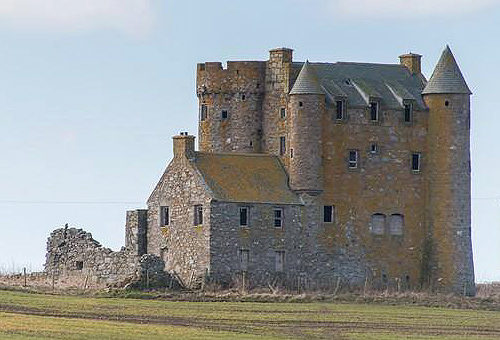 |
Inchdrewer Castle, Banff, Aberdeenshire, Scotland
Inchdrewer Castle is a 16th-century tower house in the northeast of Scotland looking across to Banff Bay. Originally owned by the Currour family, it was purchased by the Ogilvies of Dunlugas in 1557 and became their main family seat.
It was in a ruinous state when sold in 2013 after the death of Robin Mirrlees, who had owned it for about fifty years.
It is classified as a category A listed building. |
||||||||
 |
Inchdrewer Castle Banff, Aberdeenshire, Scotland.
Inchdrewer Castle is a 16th-century tower house in the northeast of Scotland. Originally owned by the Currour family, it was purchased by the Ogilvies of Dunlugas in 1557 and became their main family seat. It became uninhabited after 1836 and the structure deteriorated. It is a category A listed building. The former model Olga Roh bought it in 2014 intending to restore it. |
||||||||
 |
Inveraray Castle near Inveraray, Argyll, western Scotland.
Inveraray Castle is a country house on the shore of Loch Fyne, Scotland’s longest sea loch. It has been the seat of the Duke of Argyll, chief of Clan Campbell since the 17th century.
The house is a mostly mid-18th-century neo-Gothic design.
The 13th Duke and his family live in private apartments occupying two floors and set between two of the castle's crenellated circular towers.
Inveraray Castle is a Category A listed building. It is surrounded by a 16-acre garden and estate of 60,000 acres.
In 2012, part of the Christmas episode of Downton Abbey was filmed here; the castle stood in for the fictional "Duneagle Castle." |
||||||||
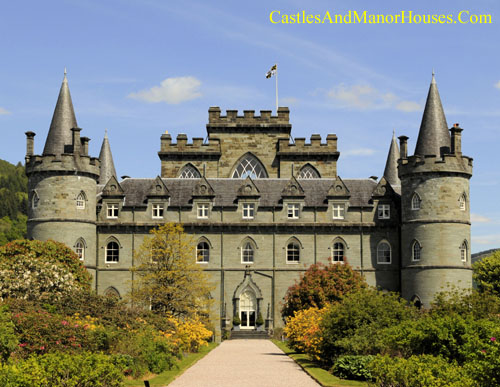 |
Inveraray Castle near Inveraray, Argyll, western Scotland.
Inveraray Castle is a country house on the shore of Loch Fyne, Scotland’s longest sea loch. It has been the seat of the Duke of Argyll, chief of Clan Campbell since the 17th century.
The house is a mostly mid-18th-century neo-Gothic design.
The 13th Duke and his family live in private apartments occupying two floors and set between two of the castle's crenellated circular towers.
Inveraray Castle is a Category A listed building. It is surrounded by a 16-acre garden and estate of 60,000 acres.
In 2012, part of the Christmas episode of Downton Abbey was filmed here; the castle stood in for the fictional "Duneagle Castle." |
||||||||
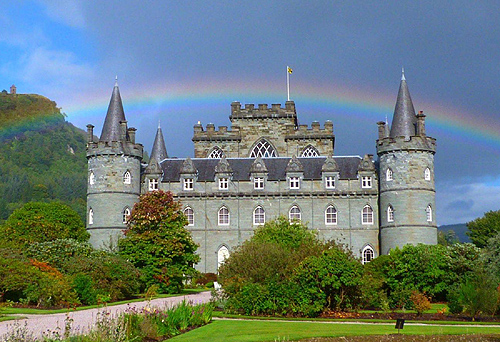 |
Inveraray Castle, Argyll, in western Scotland
Inveraray Castle is a country house near Inveraray on the shore of Loch Fyne. It has been the seat of the Duke of Argyll, chief of Clan Campbell since the 17th century.
The house is a mostly mid-18th-century neo-Gothic design.
Inveraray Castle is a Category A listed building. It is surrounded by a 16-acre garden and estate of 60,000 acres.
In 2012, the Christmas episode of Downton Abbey was partly filmed here; the castle stood in for the fictional "Duneagle Castle." |
||||||||
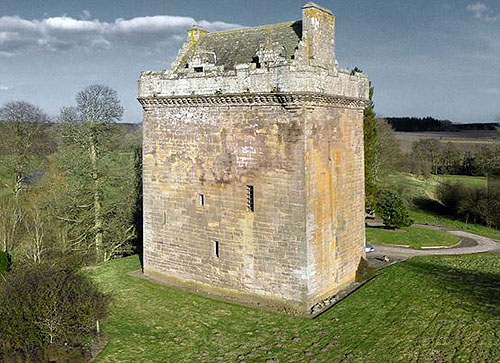 |
Inverquharity Castle, Angus, Scotland.
Inverquharity Castle is a 15th-century tower house on the south bank of the River North Esk. The lands of Inverquharity came to the Ogilvie family around 1420. The castle was first constructed as a rectangular tower in the 1440s, by Alexander Ogilvie, 2nd Lord Inverquharity. In the 16th century a wing was added to form a four-storey L-plan castle.
In the late 18th century, the tower was sold by the 5th Ogilvy Baronet, and the wing demolished. The castle decayed until the 1960s, when it was restored and the wing rebuilt.
. It remains a private family home, and is a category A listed building. |
||||||||
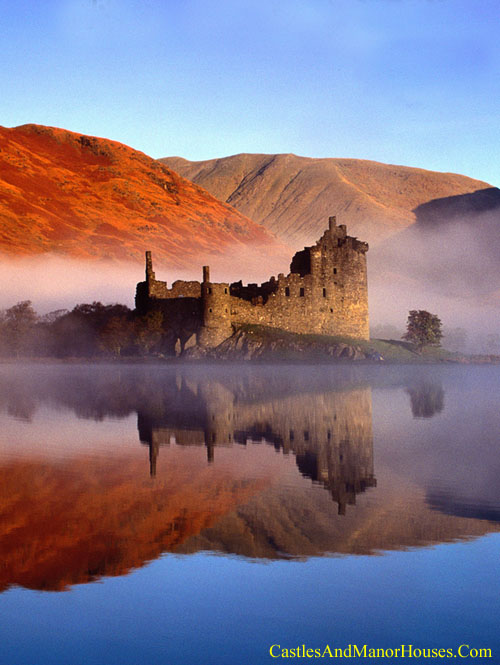 |
Kilchurn Castle Loch Awe, Argyll and Bute, Scotland.
Kilchurn Castle is a ruined 15th and 17th century structure on a rocky peninsula at the northeastern end of Loch Awe Access to the Castle is sometimes restricted by higher-than-usual levels of water in the Loch, at which times the site becomes a temporary island.
It was the ancestral home of the Campbells of Glen Orchy, later Earls of Breadalbane - the Breadalbane family branch, of the Clan Campbell. |
||||||||
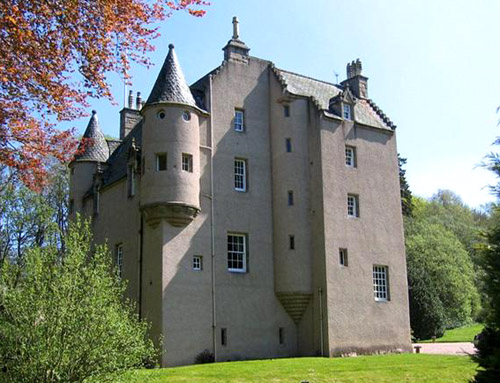
|
Lickleyhead Castle Aberdeenshire |
||||||||
 |
Mount Stuart House, Isle of Bute, Scotland
.Mount Stuart House on the east coast is a Neo-Gothic country house with extensive gardens.
It was designed by Sir Robert Rowand Anderson for the 3rd Marquess of Bute in the late 1870s, to replace an earlier house by Alexander McGill, which burnt down in 1877. |
||||||||
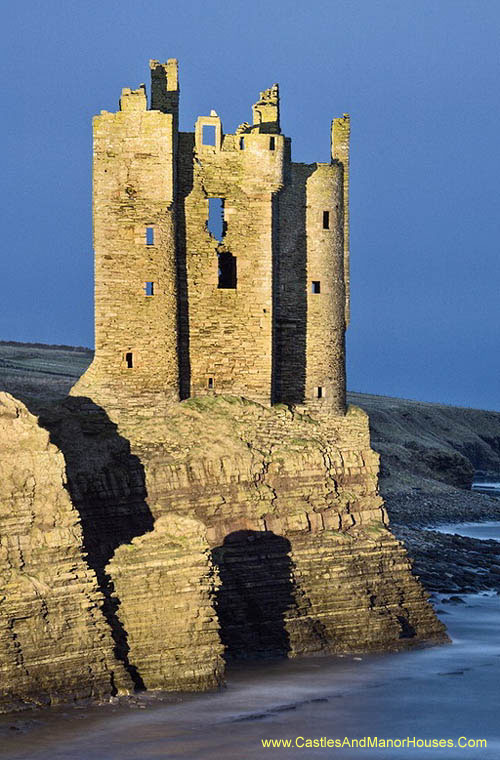 |
Old Keiss Castle north of Keiss, Caithness, Highland, Scotland.
Keiss Castle is a partially ruined castle on sheer cliffs, overlooking Sinclairs' Bay. The old castle, a Scheduled Monument, was built possibly on the site of an earlier fort in the late 16th or early 17th century by George 5th Earl of Caithness (1582-1643). |
||||||||
 |
Castle Stalker, Argyll, Scotland
Castle Stalker is a four-storey tower house set on a tidal islet on Loch Laich, an inlet off Loch Linnhe
The castle is one of the best-preserved medieval tower-houses surviving in western Scotland. It forms part of the Lynn of Lorn National Scenic Area.
Castle Stalker was brought to fame by the Monty Python team, appearing in their film Monty Python and the Holy Grail. |
||||||||
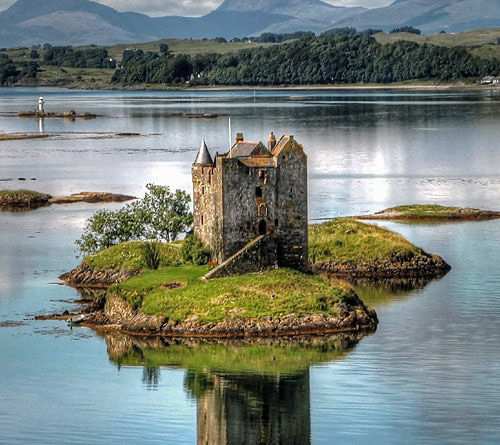 |
Castle Stalker, Argyll, Scotland
Castle Stalker is a four-storey tower house set on a tidal islet on Loch Laich, an inlet off Loch Linnhe
The castle is one of the best-preserved medieval tower-houses surviving in western Scotland. It forms part of the Lynn of Lorn National Scenic Area.
Castle Stalker was brought to fame by the Monty Python team, appearing in their film Monty Python and the Holy Grail. |
||||||||
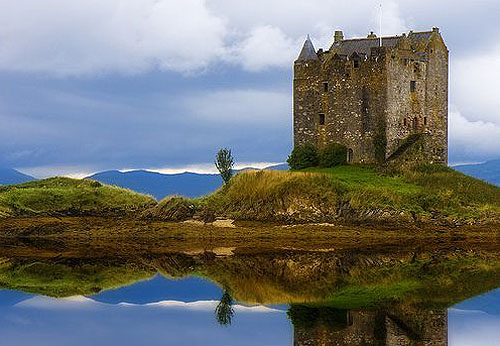 |
Castle Stalker, Argyll, Scotland
Castle Stalker is a four-storey tower house set on a tidal islet on Loch Laich, an inlet off Loch Linnhe
The castle is one of the best-preserved medieval tower-houses surviving in western Scotland. It forms part of the Lynn of Lorn National Scenic Area.
Castle Stalker was brought to fame by the Monty Python team, appearing in their film Monty Python and the Holy Grail.
|
||||||||
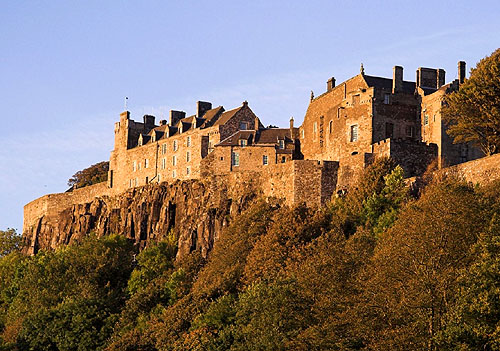 |
Stirling Castle, Stirling, Scotland
Stirling Castle is one of the largest and most important castles in Scotland. It sits on Castle Hill, an intrusive crag which forms part of the Stirling Sill geological formation. It is surrounded on three sides by steep cliffs, giving it a strong defensive position. Its strategic location, guarding what was, until the 1890s, the farthest downstream crossing of the River Forth, has made it an important fortification from the earliest times.
Most of the principal buildings of the castle date from the fifteenth and sixteenth centuries. A few structures of the fourteenth century remain, while the outer defences fronting the town date from the early eighteenth century.
Several Scottish Kings and Queens have been crowned at Stirling, including Mary, Queen of Scots, in 1542. There have been at least eight sieges of Stirling Castle.
Stirling Castle is a Scheduled Ancient Monument, and is now a tourist attraction managed by Historic Scotland. |
||||||||
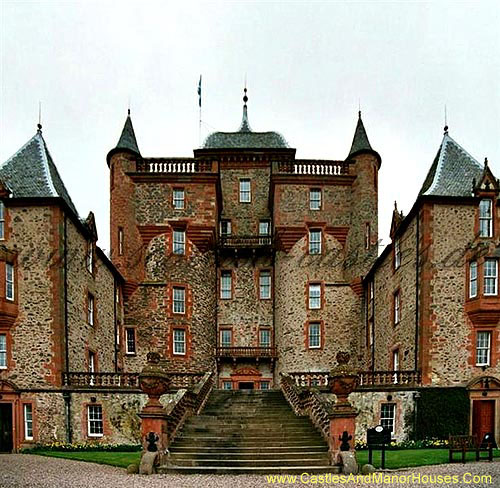 |
Thirlestane Castle Borders, Scotland.
Thirlestane Castle is a castle set in extensive parklands near Lauder. The site is named Castle Hill, as it stands upon raised ground within Lauderdale, the valley of the Leader Water. The land has been in the ownership of the Maitland family since 1587. Thirlestane served as the seat of the Earls of Lauderdale. The castle was substantially extended in the 1670s by the first and only Duke of Lauderdale. Further additions were made in the 19th century. The castle is now cared for by a charitable trust, and is open to the public. |
||||||||
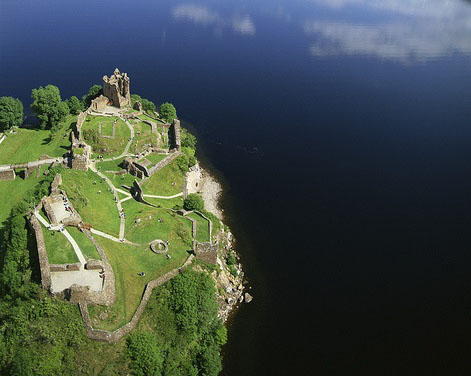 |
Urquhart Castle, Near Drumnadrochit, Highland, Scotland
Urquhart Castle sits on a headland beside Loch Ness in the Highlands of Scotland. The castle, though ruined, is one of the largest in Scotland in area.
The present ruins date from the 13th to the 16th centuries.
Urquhart Castle played a role in the Wars of Scottish Independence in the 14th century. It was subsequently held as a royal castle, and was raided on several occasions by the MacDonald Earls of Ross. The castle was granted to the Clan Grant in 1509, though conflict with the MacDonalds continued.
The castle was abandoned by the middle of the 17th century and slighted in 1692 to prevent its use by Jacobite forces. In the 20th century it was placed in state care and opened to the public: it is now one of the most-visited castles in Scotland.
|
||||||||
|
Scotland |
|||||||||
|
|
|
|
|||||||
|
|
|||||||||
| :::: Link to us :::: Castle and Manor Houses Resources ::: © C&MH 2010-2014 ::: contact@castlesandmanorhouses.com ::: Advertising ::: |